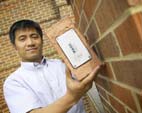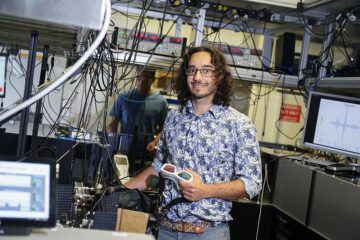Smart bricks could monitor buildings, save lives

Chang Liu, a professor of electrical and computer engineering, led the team that developed a "smart brick" that could monitor a building’s health and save lives.
A „smart brick“ developed by scientists at the University of Illinois at Urbana-Champaign could monitor a building’s health and save lives.
„This innovation could change the face of the construction industry,“ said Chang Liu, a professor of electrical and computer engineering at Illinois. „We are living with more and more smart electronics all around us, but we still live and work in fairly dumb buildings. By making our buildings smarter, we can improve both our comfort and safety.“
In work performed through the university’s Center for Nanoscale Science and Technology, Liu and graduate student Jon Engel have combined sensor fusion, signal processing, wireless technology and basic construction material into a multi-modal sensor package that can report building conditions to a remote operator.
The prototype has a thermistor, two-axis accelerometer, multiplexer, transmitter, antenna and battery hidden inside a brick. Built into a wall, the brick could monitor a building’s temperature, vibration and movement. Such information could be vital to firefighters battling a blazing skyscraper, or to rescue workers ascertaining the soundness of an earthquake-damaged structure.
„Our proof-of-concept brick is just one example of where you can have the sensor, signal processor, wireless communication link and battery packaged in one compact unit,“ Liu said. „You also could embed the sensor circuitry in concrete blocks, laminated beams, structural steel and many other building materials.“
To extend battery life, the brick could transmit building conditions at regular intervals, instead of operating continuously, Liu said. The battery could also be charged through the brick by an inductive coil, similar to those used in electric toothbrushes and certain artificial heart pumps.
The researchers are currently using off-the-shelf components in their smart bricks, so there is „lots of room for making the sensor package smaller,“ Engel said. „Ultimately, we would like to fit everything onto one chip, and then put that chip on a piece of plastic, instead of silicon, to make it more robust.“
Silicon is a rigid, brittle material, which can easily crack or break. „Sensor packages built on flexible substrates would not only be more resilient,“ Engel said, „they would offer additional versatility. For example, you could wrap a flexible sensor around the iron reinforcing bars that strengthen concrete and then monitor the strain.“
Liu and Engel have already crafted such sensors by depositing metal films on flexible polymer substrates. Dubbed „smart skin“ by its inventors, the sensor material can be wrapped around any surface of interest, such as a robotic finger. „While a typical tactile sensor can only measure surface roughness, our sensor material can determine roughness, hardness, temperature and conductivity,“ Liu said. „The combined input gives you a much better idea of the type of material being touched.“
The researchers’ smart skin is fabricated at the university’s Micro and Nanotechnology Laboratory. Although the skin is not yet wireless, Engel is working on the analog-to-digital conversion process to utilize existing wireless technology.
The smart bricks, however, are fully wireless. In addition to keeping tabs on a building’s health, applications include monitoring nurseries, daycares and senior homes, and creating interactive „smart toys“ that respond to the touch of a child.
„In a smart doll, for example, sensor capability would distinguish between caressing and slapping, allowing the doll to react accordingly,“ Liu said. „In the gaming industry, wireless sensors attached to a person’s arms and legs could replace the conventional joystick and allow a ’couch potato’ to get some physical exercise while playing video games such as basketball or tennis. The opportunities seem endless.“
The National Science Foundation funded the work.
Media Contact
Weitere Informationen:
http://www.uiuc.edu/Alle Nachrichten aus der Kategorie: Architektur Bauwesen
Die zukunftsorientierte Gestaltung unseres Wohn- und Lebensraumes erhält eine immer größer werdende Bedeutung. Die weltweite Forschung in den Bereichen Architektur und Bauingenieurwesen leistet hierzu einen wichtigen Beitrag.
Der innovations-report bietet Ihnen hierzu interessante Berichte und Artikel, unter anderem zu den Teilbereichen: Nachhaltiges Bauen, innovative Baumaterialien, Bautenschutz, Geotechnik, Gebäudetechnik, Städtebau, Denkmalschutz, Bausoftware und Künstliche Intelligenz im Bauwesen.
Neueste Beiträge

Neue universelle lichtbasierte Technik zur Kontrolle der Talpolarisation
Ein internationales Forscherteam berichtet in Nature über eine neue Methode, mit der zum ersten Mal die Talpolarisation in zentrosymmetrischen Bulk-Materialien auf eine nicht materialspezifische Weise erreicht wird. Diese „universelle Technik“…

Tumorzellen hebeln das Immunsystem früh aus
Neu entdeckter Mechanismus könnte Krebs-Immuntherapien deutlich verbessern. Tumore verhindern aktiv, dass sich Immunantworten durch sogenannte zytotoxische T-Zellen bilden, die den Krebs bekämpfen könnten. Wie das genau geschieht, beschreiben jetzt erstmals…

Immunzellen in den Startlöchern: „Allzeit bereit“ ist harte Arbeit
Wenn Krankheitserreger in den Körper eindringen, muss das Immunsystem sofort reagieren und eine Infektion verhindern oder eindämmen. Doch wie halten sich unsere Abwehrzellen bereit, wenn kein Angreifer in Sicht ist?…





















